
News Release
Mutual Fund Fees in 401(k) Plans Continue Downward Trend in 2016
Washington, DC, June 15, 2017—The cost of investing in equity, hybrid, and bond mutual funds through 401(k) plans fell again in 2016, according to a research study that the Investment Company Institute (ICI) released today. The study, “The Economics of Providing 401(k) Plans: Services, Fees, and Expenses, 2016,” also shows that participants who invest in mutual funds in their 401(k) plans tend to hold lower-cost funds.
Long-Term Trend of Declining Mutual Fund Expenses Continued in 2016
Mutual funds are a major component of the 401(k) investment landscape, comprising $3.0 trillion of the $4.8 trillion in 401(k) plan assets at year-end 2016. The average expense ratios that 401(k) plan participants incurred for investing in equity, hybrid, and bond mutual funds each fell in 2016 for the seventh straight year. For equity mutual funds, 401(k) plan participants incurred an average expense ratio of 0.48 percent, compared to 0.51 percent in 2015. The average expense ratio that 401(k) plan participants incurred for investing in hybrid mutual funds fell to 0.53 percent in 2016, from 0.54 percent in 2015. And the average expense ratio that 401(k) plan participants incurred for investing in bond mutual funds fell to 0.35 percent in 2016, from 0.38 percent in 2015.
The declines in 2016 expense ratios that 401(k) plan participants incurred for investing in equity, hybrid, and bond mutual funds are a continuation of a long downward trend. Since 2000, expense ratios that 401(k) plan participants incurred for investing in equity, hybrid, and bond mutual funds have decreased by 38 percent, 26 percent, and 43 percent, respectively (see Figure 6 in the report). Data for all figures in the report are accessible here.
“Our analysis of the fees that 401(k) plan participants pay to invest in mutual funds shows the continuation of an impressive trend of declining expense ratios since 2000,” said Sean Collins, ICI’s senior director of industry and financial analysis. “This downward trajectory, which is a boon to retirement savers, is driven by competition among funds and investors’ keen awareness of fees, among other factors.”
401(k) Mutual Fund Assets Are Concentrated in Lower-Cost Funds
ICI uses asset-weighted average expense ratios to measure the expense ratios that mutual fund investors actually incur for investing in mutual funds. The simple average expense ratio, which measures the average expense ratio of all funds offered for sale, can overstate what investors actually paid because it fails to reflect the fact that investors tend to concentrate their holdings in lower-cost funds.
In 2016, 401(k) plan participants incurred an asset-weighted average expense ratio of 0.48 percent for equity mutual funds, which was less than the asset-weighted average expense ratio of 0.63 percent incurred by all investors in equity mutual funds. Further, this was less than half the industrywide simple average of 1.28 percent for all equity mutual funds offered in the United States in 2016.
401(k) Mutual Fund Investors Tend to Pay Lower-Than-Average Expense Ratios
Percent, 2000–2016

Note: Data exclude mutual funds available as investment choices in variable annuities.
Sources: Investment Company Institute, Lipper, and Morningstar
For related research on fund fees, see “Trends in the Expenses and Fees of Funds, 2016,” which reports industry trends. For additional information about 401(k) plan fees, see The BrightScope/ICI Defined Contribution Plan Profile: A Close Look at 401(k) Plans, 2014 and Inside the Structure of Defined Contribution/401(k) Plan Fees, 2013. For more information on 401(k) plans, please visit our 401(k) Resource Center.
